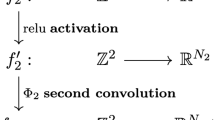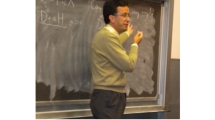Abstract
We give a formula for \(f(\eta ),\) where \(f:{\mathbb {C}} \rightarrow {\mathbb {C}}\) is a continuously differentiable function satisfying \(f(\bar{z}) = \overline{f(z)},\) and \(\eta \) is a dual quaternion. Note this formula is straightforward or well known if \(\eta \) is merely a dual number or a quaternion. If one is willing to prove the result only when f is a polynomial, then the methods of this paper are elementary.
Similar content being viewed by others
Availability of Data and Material
There is no additional data associated with this paper. No funding was provided for this paper.
References
Adorno, B.V.: Robot kinematic modeling and control based on dual quaternion algebra—part I: fundamentals (2017). hal-01478225
Agrawal, O.P.: Hamilton operators and dual-number-quaternions in spatial kinematics. Mech. Mach. Theory 22(6), 569–575 (1987)
Clifford, M.A.: Preliminary sketch of biquaternions. Proc. Lond. Math. Soc. s1–4(1), 381–395 (1871). https://doi.org/10.1112/plms/s1-4.1.381
Dunford, N., Schwartz, J.T.: Linear Operators, Part I: General Theory. Interscience (1958)
Han, D.-P., Wei, Q., Li, Z.-X.: Kinematic control of free rigid bodies using dual quaternions. Int. J. Autom. Comput. 05(3), 319–324 (2008). https://doi.org/10.1007/s11633-008-0319-1
Horn, M.E.: The Didactical Relevance of the Pauli Pascal Triangle (2006). arXiv:physics/0611277 [physics.ed-ph]
Kavan, L., Collins, S., Z̆ára, J., O’Sullivan, C.: Skinning with Dual Quaternions.https://dl.acm.org/doi/pdf/10.1145/1230100.1230107
Kavan, L., Collins, S., Z̆ára, J., O’Sullivan, C.: Geometric skinning with approximate dual quaternion blending. ACM Trans. Graph. 27(4), Article 105 (2008)
Kenwright, B.: A Beginners Guide to Dual-Quaternions, What They Are, How They Work, and How to Use Them for 3D Character Hierarchies. https://cs.gmu.edu/~jmlien/teaching/cs451/uploads/Main/dual-quaternion.pdf
Kussaba, H.T.M., Figueredo, L.F.C., Ishihara, J.Y., Adorno, B.V.: Hybrid kinematic control for rigid body pose stabilization using dual quaternions. J. Frankl. Inst. 354(7), 2769–2787 (2017)
Narasimhan, R.: Analysis on Real and Complex Manifolds, 2nd edn. North-Holland Mathematical Library (1985)
Schilling, M.: Universally manipulable body models–dual quaternion representations in layered and dynamic MMCs. Auton Robot 30, 399 (2011). https://doi.org/10.1007/s10514-011-9226-3
Schilling, M.: Hierarchical dual quaternion-based recurrent neural network as a flexible internal body model. In: International Joint Conference on Neural Networks (IJCNN), 2019, pp. 1–8 (2019). https://doi.org/10.1109/IJCNN.2019.8852328. https://ieeexplore.ieee.org/abstract/document/8852328
Selig, J.M.: Exponential and Cayley maps for dual quaternions. Adv. Appl. Clifford Algebras 20(3–4), 923–936 (2010)
Sloane, N.J.A.: Online encyclopedia of integer sequences, A051159, triangular array made of three copies of Pascal’s triangle. https://oeis.org/A051159
Wang, X., Han, D., Yu, C., Zheng, Z.: The geometric structure of unit dual quaternions with application in kinematic control. J. Math. Anal. Appl. 389(2), 1352–1364 (2012)
Wu, Y., Selig, J.M., Carricato, M.: Parallel robots with homokinetic joints: the zero-torsion case. In: Uhl, T. (eds.) “Advances in Mechanism and Machine Science.” IFToMM WC 2019. Mechanisms and Machine Science, vol. 73, pp. 269–278. Springer, Cham (2019)
Yang, X.L., Wu, H.T., Li, Y., Chen, B.: A dual quaternion solution to the forward kinematics of a class of six-DOF parallel robots with full or reductant actuation. Mech. Mach. Theory 107, 27–36 (2017). https://doi.org/10.1016/j.mechmachtheory.2016.08.003
Funding
The author has no relevant financial or non-financial interests to disclose. The authors certify that they have no affiliations with or involvement in any organization or entity with any financial interest or non-financial interest in the subject matter or materials discussed in this manuscript, except that this is related to consulting work performed by the author for the NASA Johnson Space Center, Houston, Texas, USA. The author has no financial or proprietary interests in any material discussed in this article.
Author information
Authors and Affiliations
Corresponding author
Ethics declarations
Conflict of interest
The author has no competing interests to declare that are relevant to the content of this article.
Additional information
Communicated by Uwe Kaehler.
Publisher's Note
Springer Nature remains neutral with regard to jurisdictional claims in published maps and institutional affiliations.
Rights and permissions
Springer Nature or its licensor (e.g. a society or other partner) holds exclusive rights to this article under a publishing agreement with the author(s) or other rightsholder(s); author self-archiving of the accepted manuscript version of this article is solely governed by the terms of such publishing agreement and applicable law.
About this article
Cite this article
Montgomery-Smith, S. Functional Calculus for Dual Quaternions. Adv. Appl. Clifford Algebras 33, 36 (2023). https://doi.org/10.1007/s00006-023-01282-y
Received:
Accepted:
Published:
DOI: https://doi.org/10.1007/s00006-023-01282-y




